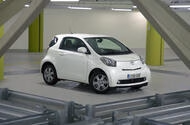Why Did Toyota Create the IQ, and What Made It Stand Out?
Ever wondered what happens when a carmaker decides to rethink the city car from the ground up? That’s exactly what Toyota did with the IQ. The name itself is a bold statement—suggesting cleverness, innovation, and a certain confidence that this little car would outsmart its rivals. But was it really as smart as its name implied?
Toyota’s IQ wasn’t just another small car. It was a radical experiment in packaging and design. At less than three meters long, it was actually shorter than the classic Mini, yet nearly a foot wider. This wasn’t just for show. The extra width meant more interior space, and the unique proportions gave it a presence that set it apart from the crowd. Toyota wanted the IQ to fit into the same footprint as a tiny Japanese kei car, but with more room and safety than you’d expect from something so compact.
How Did Toyota Squeeze So Much Into Such a Small Package?
Here’s where things get really interesting. Toyota’s engineers spent five years—two more than usual for a small car—figuring out how to cram four seats, real crash protection, and decent motorway manners into a car barely bigger than a shopping cart.
They pulled out all the stops. The transmission was reengineered so the differential sat in front of the engine, shortening the front overhang and freeing up cabin space. The front passenger seat was nudged forward, giving rear passengers a bit more legroom (well, a smidge more). Rear dampers were mounted horizontally—a trick borrowed from Peugeot—to eke out every last cubic inch. Even the fuel tank was flattened and tucked under the floor. The result? A car that felt surprisingly roomy for its size, with clever touches everywhere you looked.
What Was It Like to Drive the Toyota IQ?
You might expect a car this small to feel twitchy or out of its depth on the open road. But here’s the twist: the IQ was unexpectedly good at motorway cruising. Its wide stance and high gearing meant it tracked straight and true, shrugging off crosswinds and the buffeting from passing trucks. The cabin was impressively quiet and comfortable for long journeys, especially compared to other city cars of the time.
Around corners, the IQ’s width gave it a stable, planted feel. The steering was quick and precise, letting you make the most of its grip. It wasn’t fast—67 horsepower from a 1.0-litre engine only goes so far—but it felt confident and composed, even at higher speeds.
Was the IQ Really a Great City Car?
Here’s where things get a bit complicated. On paper, the IQ should have been the ultimate city runabout. In reality, it was a mixed bag. The extra width that made it so stable on the motorway also made it harder to squeeze through tight gaps in traffic or snag that elusive parking spot. The tall gearing, designed for fuel economy, left it feeling a bit sluggish when you needed to dart away from a stoplight.
Visibility was another sore spot. The thick pillars—necessary for safety in such a small car—created blind spots that made urban driving trickier than it should have been. And the boot? Let’s just say you’d struggle to fit much more than a small grocery bag, or perhaps a vacuum-packed fish if you were feeling adventurous.
Could the IQ Really Seat Four People?
Technically, yes. In practice, it was more of a 3+1 setup. The front passenger seat was pushed forward, so a child or a very patient adult could fit behind it. Two adults in the back would feel like sardines, and the view out wasn’t exactly panoramic thanks to those swirling side pillars. Still, for short trips or occasional use, it was more flexible than most cars its size.
Why Didn’t the IQ Become a Best-Seller?
Despite its clever engineering and unique style, the IQ never really caught on with mainstream buyers. Part of the problem was price—it cost significantly more than most city cars, and even some larger superminis. Toyota tried to justify this with a high-quality interior and lots of innovative features, but for many shoppers, the numbers just didn’t add up.
There was also the question of identity. Was it a city car? A stylish commuter? Something in between? In trying to be all things to all people, the IQ ended up a bit of a niche product.
What’s the IQ’s Legacy Today?
Here’s the thing: the Toyota IQ may not have been a runaway commercial success, but it’s become something of a cult classic. Its originality, charm, and sheer audacity have earned it a loyal following among enthusiasts and collectors. The fact that Toyota never made a direct replacement only adds to its mystique.
And if you really want to see the IQ’s weirdest twist, look no further than the Aston Martin Cygnet—a luxury-badged version that took the concept to a whole new level. But that’s a story for another day.
What Can We Learn From the Toyota IQ’s Story?
The IQ’s tale is a reminder that innovation doesn’t always guarantee commercial success, but it can leave a lasting impression. Toyota dared to challenge the norms of city car design, and while the result wasn’t perfect, it was undeniably bold. For drivers who value originality and clever engineering, the IQ remains a standout—flawed, yes, but brilliantly so.
If you ever spot one on the road, give it a second look. It’s not just another small car. It’s a testament to what happens when automakers think outside the box—literally and figuratively. And sometimes, that’s exactly what the world needs.

